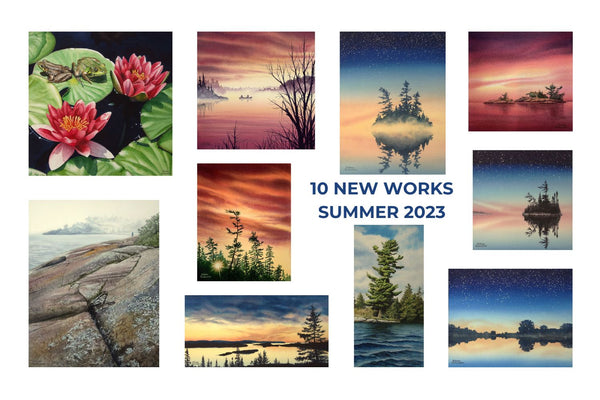 Last spring, fortunate folks from around the world were privileged to witness spectacular displays of northern lights.
Last spring, fortunate folks from around the world were privileged to witness spectacular displays of northern lights.
Many people posted their photos of this cosmic magic online so the rest of us could enjoy it too.
Several of my previous clients were caught up in the excitement of these celestial sightings and asked me if I would create some paintings of northern lights to add to their collections.
This inspired me to produce a series of eleven aurora paintings this spring and summer. Six pieces were done in more traditional green and blue hues. The other five artworks were inspired by the pinks, oranges, and yellows seen in recent aurora events.
All eleven scenes are imaginary places, but their details come from my close observation of nature. It takes at least five layers of paint to build up the intense colour and soft transitions of the aurora skies. (Not to mention lots of practice, and several failed attempts, to determine the right painting strategy!)
Let me introduce you to this new group of paintings.

Sky Magic (commission), varnished watercolour on 10 x 10 inch panel (sold). Northern lights curve through the heavens, echoing the rolling hills of a winter wonderland. Sturdy northern trees nestled in snowy beds create bold silhouettes against this magical sky.

Sky Dance, varnished watercolour on 10 x 10 inch panel $600. Northern lights waltz across the night sky in a luminous cosmic dance. Their glorious hues and shapes contrast dramatically with a stark winter landscape. Click here to see framed views of this painting.

Passing Through, varnished watercolour on 11 x 14 inch panel $900. Northern lights are an awe-inspiring sight. They billow and flow over the wintry land, quickly passing through the night skies as we gaze on in wonder. Click here for more information about this artwork.

Northern Frolic, (commission) varnished watercolour on 4 x 6 inch panel (sold). Sometimes the aurora appear in spring or fall when lakes are open to reflect the lively celestial dance.

Northern Delight, (commission) varnished watercolour on 4 x 6 inch panel (sold). This small painting was a test piece for a larger composition, but turned out well enough to stand on its own merits.

Royalty on the Ridge, varnished watercolour on 16 x 20 inch panel (sold). This painting came about when I wondered what northern lights would look like combined with two iconic northern features - white pines and a rocky ridge. Adding a full moon completed the majestic scene. This piece has found a home with a collector in South Dakota.

Evening Magic (commission), varnished watercolour on 12 x 9 inch panel (sold). Last spring, the pinks and yellows of the aurora were unusual and amazing, especially when reflected on peaceful northern lakes. This painting now resides in Czechoslovakia.

Evensong (commission), varnished watercolour on 10 x 10 inch panel (sold). It was pure joy to work with these intense colours. They contrast dramatically with the starry night sky and the trees on this wee island.

Watching the Show, varnished watercolour on 12 x 9 inch panel $650. This display of colourful northern lights shines through the night sky like a prism. White pines angled down the hill remind me of stadium seating at a concert. They have a front row seat for the cosmic performance. Click here to see framed views of this piece.

Witnessing Wonder, varnished watercolour on 12 x 9 inch panel $650. Northern lights dance across the night sky in rippling rays of prismatic colour. Like the venerable white pine in the foreground, we are privileged to witness this celestial wonder. Click here for more details about this painting.

Springtime Aurora, varnished watercolour on 10 x 10 inch panel $600. In this scene, glowing hues of the aurora contrast dramatically with tree-covered islands in a vast northern lake. Click here to see framed views of this artwork.
I hope you have enjoyed this parade of new paintings. It was very satisfying to imagine and invent beautiful wild places bathed in spectacular aurora light.
If you have comments you wish to share, please do so using the 'Leave a Comment' button at the top of this post.
Subscribe to Karen's Newsletter for exclusive early access to new work, studio news updates, travel tales, painting tips, and notices of upcoming exhibitions.



 Twenty years ago, my husband and I spent a sunny August weekend at a lodge on a cluster of tiny islands in Georgian Bay. While kayaking there, I was treated to my first up-close views of the iconic rock of that region of Ontario.
Twenty years ago, my husband and I spent a sunny August weekend at a lodge on a cluster of tiny islands in Georgian Bay. While kayaking there, I was treated to my first up-close views of the iconic rock of that region of Ontario. 
 A Place of the Heart, varnished watercolour on 14 x 11 inch panel, $900.
A Place of the Heart, varnished watercolour on 14 x 11 inch panel, $900.
 The Windy Shore, varnished watercolour on 20 x 16 inch panel, $1500.
The Windy Shore, varnished watercolour on 20 x 16 inch panel, $1500.





 The most difficult part of this scene, believe it or not, was the forest. I knew I had to get that right before I invested weeks and weeks into painting stones.
The most difficult part of this scene, believe it or not, was the forest. I knew I had to get that right before I invested weeks and weeks into painting stones.
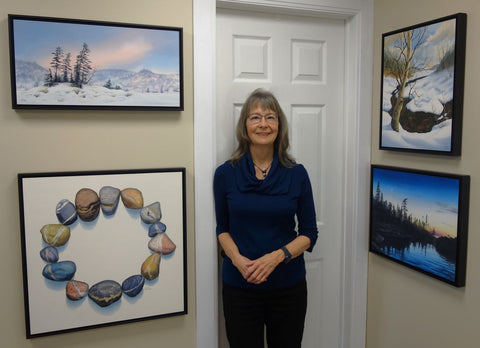

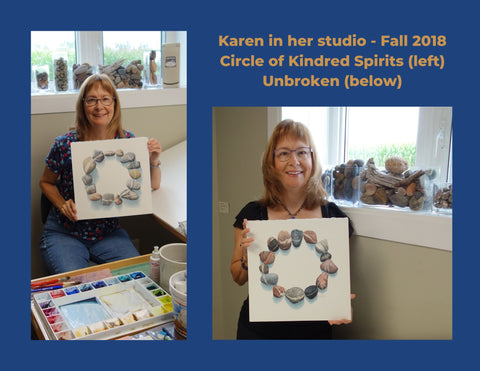

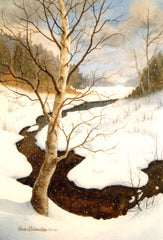
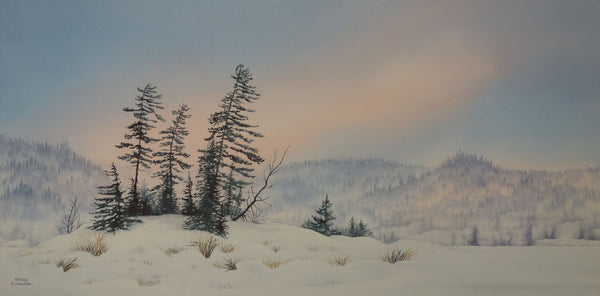
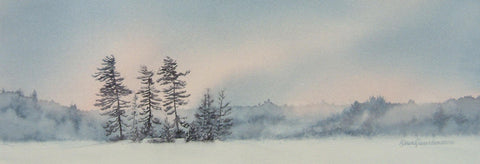
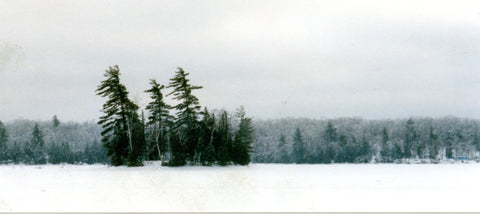
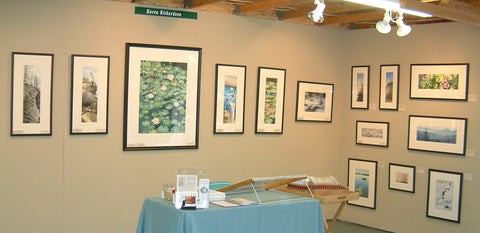 This is a photo of my booth at the 2006 Buckhorn Fine Art Festival, where Enchantment was sold to a collector. It is the tiny painting in the middle of the far right wall. In those days, I was framing my watercolours with mats and glass. Now I mount them on art boards and varnish with a UV blocking coating, eliminating the need for glass. You can read about my framing process in this article:
This is a photo of my booth at the 2006 Buckhorn Fine Art Festival, where Enchantment was sold to a collector. It is the tiny painting in the middle of the far right wall. In those days, I was framing my watercolours with mats and glass. Now I mount them on art boards and varnish with a UV blocking coating, eliminating the need for glass. You can read about my framing process in this article: 
 This is the third time I have painted this scene, and it resonates so powerfully with me, I feel like I could paint it again sometime in the future. This artwork celebrates all I hold dear about northern scenery: vast skies, clear blue water, smooth stones, and hardy pine and spruce trees.
This is the third time I have painted this scene, and it resonates so powerfully with me, I feel like I could paint it again sometime in the future. This artwork celebrates all I hold dear about northern scenery: vast skies, clear blue water, smooth stones, and hardy pine and spruce trees.
 She was on a back country camping trip and her party stayed overnight in tents on this beach. She graciously granted me permission to use her stunning sunset photo (shown left) as reference for my artwork.
She was on a back country camping trip and her party stayed overnight in tents on this beach. She graciously granted me permission to use her stunning sunset photo (shown left) as reference for my artwork. In my last post, I told the
In my last post, I told the  My photo of a tree growing from a rocky cliff was taken on the Port au Port peninsula near Stephenville, and my photo of large boulders was from Gros Morne National Park.
My photo of a tree growing from a rocky cliff was taken on the Port au Port peninsula near Stephenville, and my photo of large boulders was from Gros Morne National Park.






























